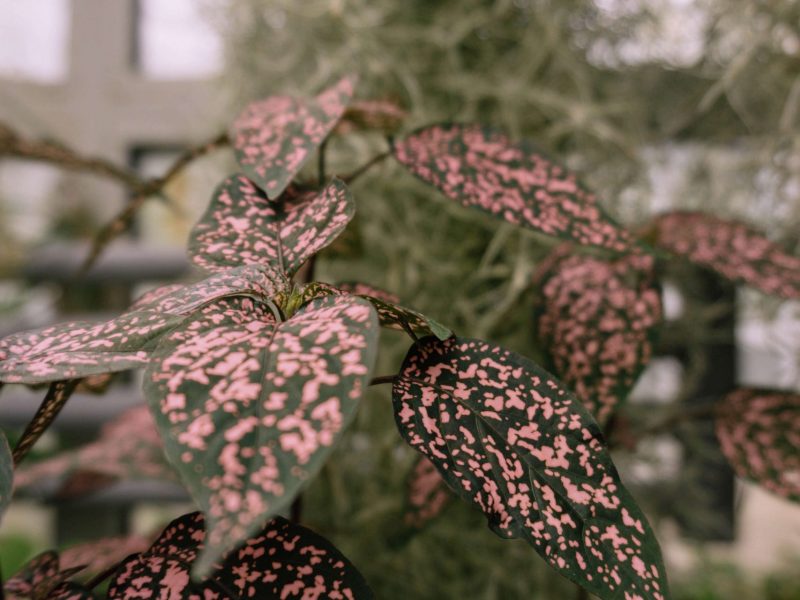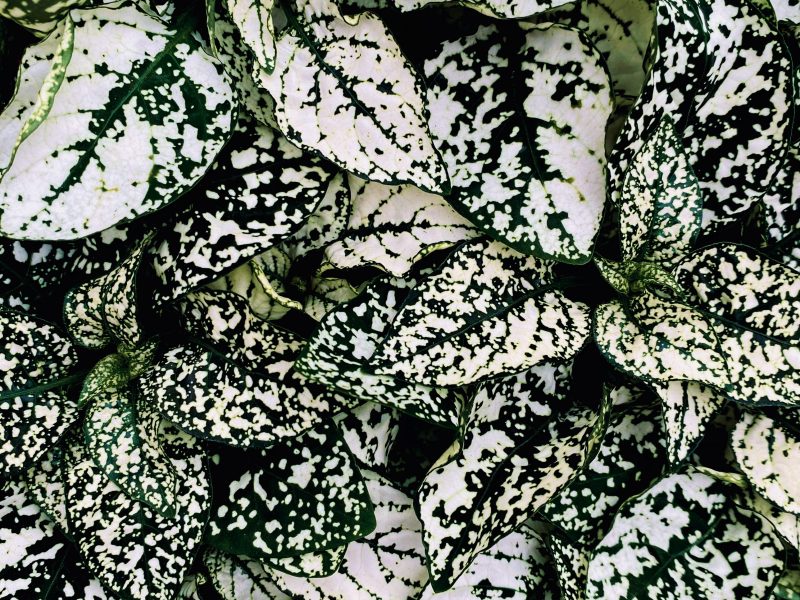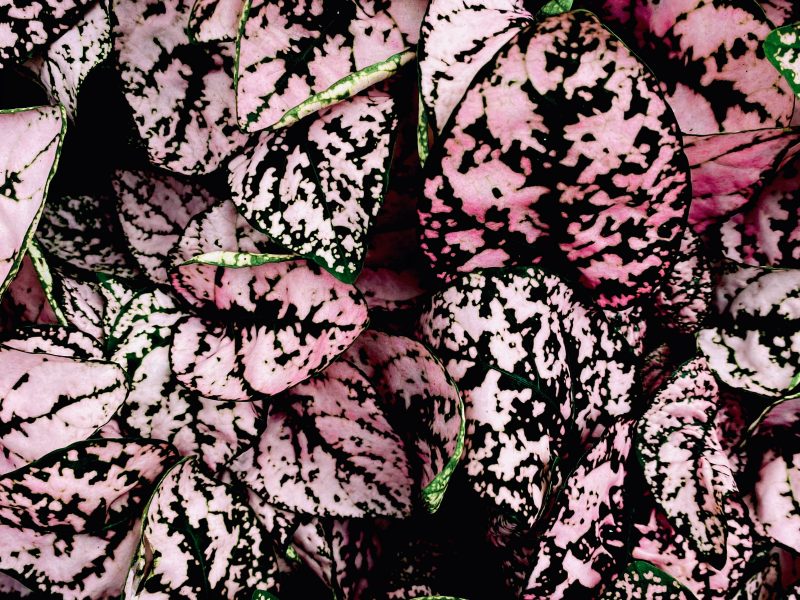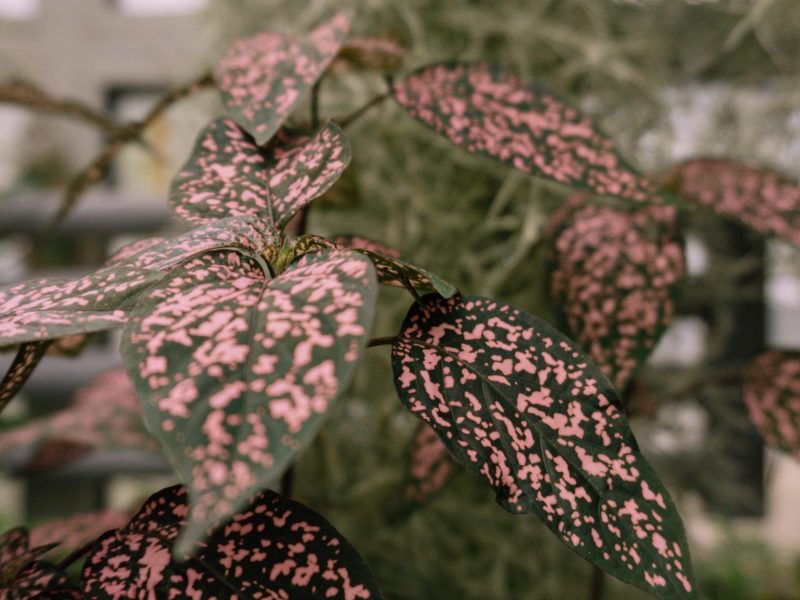Polka Dot Plant

Introduction to Polka Dot Plants
Originating from Madagascar, Polka Dot Plants (Hypoestes phyllostachya) are vibrant, eye-catching plants known for their spotted foliage, which comes in a variety of colors. The polka dots usually appear in contrasting hues, in colors including red, pink and white.
Caring for a Polka Dot Plant
While Polka Dot Plants may seem a bit demanding, the overall care process is not overly complex, it’s just quite specific. It involves providing the right environment, watering properly, and maintaining ideal temperature and humidity levels. The plant also requires regular feeding and occasional pruning to maintain strong new growth.
History and Origin of Polka Dot Plants
Although the Polka Dot Plant is now a common sight in many parts of the world, it wasn’t always this way. It was only in the mid-19th century that European explorers were drawn to its colorful foliage and brought it back to the Western world. The fascination with its dotted pattern quickly spread, leading to its current popularity.
Among the native Malagasy people, the Polka Dot Plant is more than just an attractive plant and was traditionally used for medicinal purposes. The leaves are often crushed and used to treat ailments such as fever and inflammation.
The Polka Dot Plant’s scientific name, Hypoestes phyllostachya, also offers a clue to its distinctive appearance and environmental requirements. Hypoestes translates from Greek as ‘under a house’, referencing its natural growth under the canopy of larger plants, while Phyllostachya means ‘leaf spike’, hinting at its leaf shape.
Polka Dot Plant Varieties
- Pink Polka Dot Plant: Renowned for its bright pink spots against a dark green backdrop, this variety is a favorite among plant enthusiasts.
- Red Polka Dot Plant: This variant features bolder, redder spots, creating a striking contrast with its green leaves.
- White Polka Dot Plant: Sporting white spots on green leaves, this variety offers a more subdued but equally charming aesthetic.
Lighting Needs of a Polka Dot Plant
Indoor Lighting
When growing a Polka Dot Plant indoors, place it near a window that receives plenty of natural light. However, be sure to avoid direct sunlight, as it can scorch the leaves. If necessary, you can use sheer curtains to filter the light or place it slightly further inside the room, away from the direct rays coming through the window.
Outdoor Lighting
If you prefer to grow your plant outdoors, select a spot that gets dappled sunlight or is shaded for part of the day. Full sun exposure can lead to leaf burn, while too little light may cause the plant to lose its distinctive coloration.
If the plant isn’t getting enough light, it will “stretch” towards the source, a process known as etiolation. This can result in a tall, leggy plant with sparse foliage so make sure that your plant is getting enough sunlight year round to prevent this.
Watering your Polka Dot Plant
These plants enjoy a moist environment but do not fare well in overly saturated soil so make srue that the potting mix is able to dry out briefly between waterings.
How Often To Water:
The frequency of watering depends primarily on the climate and the time of year. Generally, watering should occur when the top layer of soil feels dry to the touch. This might mean watering every couple of days during hotter periods and reducing the frequency during cooler months.
Watering Technique:
When watering your Polka Dot Plant, aim to water it thoroughly, allowing the water to drain from the bottom of the pot. This approach ensures that the roots get enough moisture without the risk of overwatering. Avoid letting the plant sit in standing water, as this can lead to root rot.
Tips for Watering Polka Dot Plants
- Water in the morning: Watering your plant early in the day gives it time to dry out a little before temperatures drop at night.
- Use room-temperature water: Extremely cold or hot water can shock or burn the plant, leading to leaf drop. Room-temperature water is best to avoid any issues.
- Consider the potting mix: A well-draining potting mix is crucial in preventing waterlogged soil. If the soil remains damp for too long, consider amending it with perlite or a similar substance to improve drainage.
Humidity and Temperature Requirements
Temperature
The Polka Dot Plant can tolerate a wide range of temperatures, but it thrives best in a warmer climate. The ideal temperature for the Polka Dot Plant ranges between 70°F to 80°F (21°C to 27°C).
It’s important to know that these plants really hate the cold and temperatures below 60°F (15°C) can cause harm, leading to wilting or even plant death (if the issue persists). It’s best to keep your plant in a location where the temperature is consistently warm and respond quickly to any fluctuations.
Humidity
As they are native to a tropical environment, the Polka Dot Plant enjoys a high level of humidity. This is why it’s often found to thrive in bathrooms or kitchens, where humidity levels are naturally higher.
If your home environment is dry, you will need to increase humidity levels to avoid issues such as brown leaf tips and edges that are one of the most common problems for Polka Dot Plants. Here are a few ways to do this:
- Mist a few times a week: Use a spray bottle to mist your Polka Dot Plant with water on a regular basis. This helps to replicate the moist air of a tropical environment.
- Buy a humidifier: A great way to maintain the necessary humidity levels is by using a humidifier, especially during winter when indoor air tends to be drier.
- Make a pebble tray: Place your pot on a tray filled with pebbles and water. As the water evaporates, it will create a humid microclimate around your plant. The reason you want to have pebbles in the tray is so that your plant’s roots are not sitting in a puddle of water.
White Polka Dot Plant

How to Fertilize your Polka Dot Plant
Frequency
Typically, your Polka Dot Plant needs to be fertilized once a month during the growing season, from spring through early fall. In the winter months, you should stop fertilizing altogether as your plant is in a dormant phase.
Type of Fertilizer
Choose a balanced, water-soluble fertilizer to meet the nutritional needs of your Polka Dot Plant. The fertilizer should be rich in nitrogen, phosphorus, and potassium. Look for a formulation with an equal ratio of these elements, such as a 20-20-20 or 10-10-10 mix. You can also use fertilizer sticks or granules but we recommend liquid fertilizer as it is easier to control.
Application
The fertilizer should be applied following the package instructions. Dissolve the recommended amount in water and apply to the soil. We often will dilute it more than recommended for Polka Dot Plants as they can be a little sensitive to overfertilization and this is the best way to avoid this. Be careful as well not to splash it on the leaves, as it could cause them to burn.
If you are fertilizing too much each time (or too frequently) this can lead to salt build-up in the soil, which can damage the roots of your Polka Dot Plant. If you notice the tips of your plant’s leaves turning brown or small yellow patches on the leaves, you might be over-fertilizing.
Repotting your Polka Dot Plant
Repotting your Polka Dot Plant is a fundamental aspect of its care as these plants frequently become root-bound. Ideally, you should aim to repot your Polka Dot Plant every 1-2 years preferably in the springtime when the plant begins its growing phase.
Here’s a step-by-step guide to help you through the process:
- Choose a new pot that is one size larger than the current one. Ensure it has good drainage.
- Carefully remove the plant from its current pot. Try not to damage the roots but don’t worry if you do break a couple of them as this won’t cause any issues.
- Inspect the roots for any signs of disease or decay and trim dead or dying roots if necessary.
- Place a layer of fresh potting mix in the new pot.
- Position your Polka Dot Plant in the new pot and gently fill in with more potting mix, ensuring the plant is secure.
- Water the plant thoroughly after repotting to help it settle into its new home.
Pruning Polka Dot Plants
One of the essential aspects of caring for your Polka Dot Plant is proper pruning. This not only helps the plant maintain its vibrant and bushy appearance but also helps to fight disease and common problems.
Pruning Your Polka Dot Plant
Pruning is a crucial part of Polka Dot Plant care. This process encourages bushier growth and helps maintain the plant’s compact form. Polka Dot Plants have a tendency to become leggy if not pruned regularly so make sure you build this into your regular care routine.
- When to Prune: Ideally, you should prune your Polka Dot Plant during the spring or early summer but if you are pruning brown, yellow or wilted leaves, do this at any point in the year.
- How to Prune: Using clean, sharp scissors or pruning shears, cut back the leggy stems to the desired length. Always make your cuts just above a leaf node.
Polka Dot Plant Toxicity
The Polka Dot Plant (Hypoestes phyllostachya) is generally considered non-toxic to both humans and pets.
However, it’s always best to exercise caution. Despite its non-toxic status, ingesting any part of a Polka Dot Plant can cause mild gastrointestinal upset for some individuals or pets. Symptoms may include: nausea, vomiting, diarrhea.
If you or your pet displays any of these symptoms after ingestion, it’s advised to consult with a healthcare professional or a veterinarian.
Flowers on a Polka Dot Plant
Appearance of Flowers:
The flowers on a Polka Dot Plant are typically small with a soft pink hue. They are often overlooked due to the bright and vibrant foliage of the plant, but they are always a nice surprise if they do pop out!
Timing:
Flowering usually occurs in late spring to early summer. However, under optimal conditions, sporadic blooming can occur at different times of the year. It’s worth noting though that flowering in most houseplants is very unpredictable and oftentimes rare so don’t get your hopes up too much.
Care During Flowering:
During the flowering period, it’s essential to keep the plant well-hydrated but not overwatered. It’s also a good idea to provide the plant with a balanced fertilizer to support its growth and flowering.
Post Flowering Care:
Once the flowering period is over and the flowers have started to die, remove them from your plant so that it can focus its energy on new healthy leaves.
Cleaning your Polka Dot Plant
Your Polka Dot Plant needs to be kept clean to ensure its overall health and well-being. Dust and dirt can accumulate on the leaves, hindering the plant’s ability to photosynthesize and breathe as the pores can get quite clogged up. Aesthetically your plant will look a lot brighter and fresher with a regular clean.
Regular Cleaning
- Prepare a soft cloth or sponge: Choose an item that is soft enough not to damage the plant’s leaves. If you opt for a cloth, a microfiber cloth is recommended as it can effectively pick up dust without causing harm to the delicate leaves and stems.
- Dampen the cloth or sponge with water: The cloth or sponge should be damp, but not soaking wet. You’re looking to wipe away the dust, not drench the plant.
- Gently wipe each leaf: Start from the base of the leaf, working your way to the tip. Be gentle to avoid breaking or damaging the leaves.
Deeper Cleaning
Once in a while, your Polka Dot Plant might need a deeper clean, particularly if it’s been neglected for a while or if it’s been exposed to a dusty environment. Here’s how to do it:
- Prepare a mild soap solution: Mix a small amount of mild liquid soap with water. Be sure not to use a soap that’s too harsh or that contains harmful chemicals as that can really damage the leaves quite quickly.
- Use a soft cloth or sponge: Just like with regular cleaning, you’ll want to use a soft cloth or sponge to do the cleaning.
- Wipe each leaf with soapy water: Gently wipe each leaf, starting from the base and working your way to the tip. Be sure to also clean the undersides of the leaves and support the leaf with your other hand when cleaning so you don’t damage the plant.
- Rinse with water: Once you’ve wiped each leaf with soapy water, rinse the plant thoroughly with plain water to remove any soap residue.
Pink Polka Dot Plant Leaves

Common Pests and Diseases of Polka Dot Plants
Pests
While rare, these three pests have a tendency to infest a Polka Dot Plant:
- Spider mites: These tiny arachnids are often too small to see with the naked eye, but they can cause significant damage if you don’t spot the infestation quickly. Signs of an infestation include yellowing leaves and a fine, white webbing on the plant.
- Mealybugs: These pests appear as tiny, white cottony spots on the plant. They feed on the plant’s juices, causing the leaves to yellow and potentially drop off.
- Aphids: These small, green insects also feed on plant sap, causing similar damage to mealybugs. You might notice a sticky residue on the leaves or nearby surfaces.
Diseases
- Root rot: Typically caused by overwatering, root rot can turn the leaves yellow or brown, and the plant may appear wilted. If you notice this issue when the soil is still waterlogged, replace it immediately rather than waiting for it to dry out to prevent further issues.
- Leaf spot: This disease causes dark spots on the leaves. It’s often a result of high humidity or water left sitting on the leaves.
- Powdery mildew: This appears as a white or grey powdery substance on the leaves and stems. It’s usually caused by poor air circulation and high humidity.
Polka Dot Plant FAQs
How much sunlight does a Polka Dot Plant need?
It’s important that your Polka Dot Plant doesn’t receive any direct sunlight. This is because their leaves are so delicate that intense sun will quickly dry them out and scorch them. Instead, you want to find a spot that has plenty of indirect sunlight to keep your Polka Dot Plant thriving.
If your Polka Dot Plant does receive too much sunlight, then it may lead to leggy growth.
Is the Polka Dot Plant a low-maintenance houseplant?
Polka Dot Plants fit somewhere in between a beginner and a fussy houseplant. They can be quite fussy about things like humidity and watering but once you’ve nailed down a good routine, they shouldn’t give you too much hassle and will reward you with plenty of new incredible foliage.
Where is the Polka Dot Plant native to?
The Polka Dot Plant is native to South East Asia, South Africa and Madagascar.
Is the Polka Dot Plant toxic to pets?
The Polka Dot Plant is relatively non-toxic but can cause some stomach irritation if ingested in large quantities.
Common Problems with your Polka Dot Plant
Why is my Polka Dot Plant leggy?
Leggy growth can occur as your Polka Dot Plant ages. It can become more of a problem if your plant isn’t getting enough light which is why you’ll often see more leggy growth during autumn and winter. This isn’t due to anything you’ve done wrong but just due to lower light levels.
To avoid further leggy growth on your Polka Dot Plant, move your plant a little closer to the window to allow it to get more light. You may also choose to supplement light levels with an LED grow light. These can be great for getting your houseplants through the winter as well as for seedlings and propagation.
You may choose to trim away the leggy stems as this can encourage bushier growth and will look better aesthetically.
My Polka Dot Plant's leaves have discoloured
If your Polka Dot Plant’s leaves are fading or discolouring then it may be due to intense levels of direct sunlight or a pest infestation. Take a close look at the leaves to see if you can spot any pests or holes which could indicate bugs.
Why is my Polka Dot Plant wilting?
A consistent lack of water can cause your Polka Dot Plant to become dry and wilt. Check the moisture in the soil to confirm and adjust your watering schedule accordingly.
Why is my Polka Dot Plant dying?
There are several factors which may be causing your Polka Dot Plant to die. First, check the soil to see if there is too much or too little moisture. Then monitor the amount of sunlight it is getting as well as if it needs misting or moving to a warmer room. A rarer cause of Polka Dot Plants dying is pests so check the leaves regularly to spot bugs such as mealybugs, scale insects and aphids.














